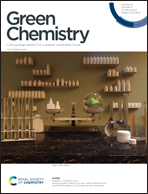Highly efficient doping of titanium dioxide with sulfur using disulfide-linked macrocycles for hydrogen production under visible light†
Abstract
Doping sulfur into TiO2 can narrow the bandgap of native TiO2, offering an efficient way to improve its photocatalytic efficiency and extend its absorption from the ultraviolet to the visible light region. However, its low doping efficiency has remained a stumbling block in the advanced development of sulfur-doped TiO2 (S-TiO2). Here, we demonstrated disulfide macrocycles (DSMs) as ideal candidates for efficiently engineering TiO2 with sulfur. Inductively coupled plasma atomic emission spectroscopy (ICP-AES) analysis showed that the sulfur doping content in the entire S-TiO2 was about 1.5 wt%, while its surface contained about 2.0 wt% sulfur determined by X-ray photoelectron spectroscopy (XPS), using only 5.0 wt% DSM as the dopant. The overall utilisation rate of sulfur was determined to be about 95%, which was much higher than those of reported examples. The XPS analysis of the S-TiO2 material suggested that the sulfur element was in the S6+ form on the crystal lattice by replacing Ti4+ and the surface of TiO2 with the formation of SO42−. The energy bandgap of S-TiO2 was 2.3 eV, a reduction compared to 3.2 eV of native TiO2, which allowed the extension of the light absorption range of the engineered material to 700 nm. Accordingly, the materials, loaded with platinum nanoparticles, photo-catalytically split water into hydrogen under visible light. The hydrogen production performance was about 573.3 mmol g−1 h−1 (based on the mass of platinum) and remained similar even after 50 h, with a turnover number of 4990. Our findings indicate that DSMs are efficient dopants for modifying TiO2 with sulfur. The high-efficiency doping of TiO2 with sulfur from the macrocycles significantly reduced the amounts of dopants needed, presenting a possibility for the green industrial production of S-TiO2 in the future.



 Please wait while we load your content...
Please wait while we load your content...